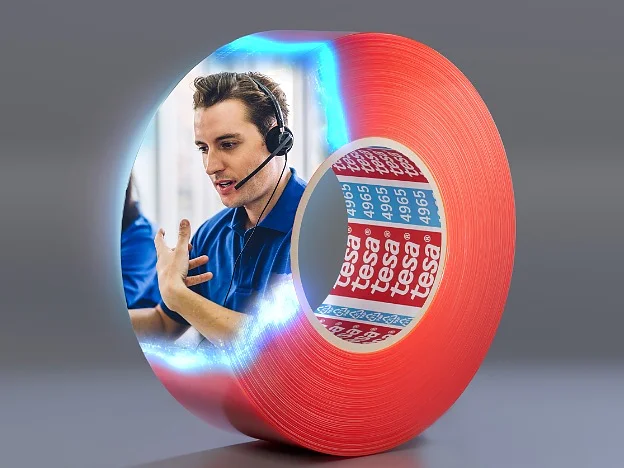

Frequently asked
questions
FAQs about tesa® 4965 Original Next Gen
We have presented tesa® 4965 Original Next Gen and highlighted its value and retained performance, showcasing the implemented changes towards a more sustainable future.
Here we will answer more of the questions that customers want to know about this adhesive solution and how it might affect their processes.
FAQs - your questions answered
What does the ‘40% less CO₂’ claim mean?
We will reduce the emission of carbon dioxide into the environment by exchanging the raw material feedstocks. In other words, we succeeded in reducing the carbon footprint of our tape mitigating the impact of our tape on climate change and the effects occurring all over the world. We project that this strategic change will save approximately 2250 tons of CO2 every year and reduce the carbon footprint of customers’ individual products which utilize the improved new tape version tesa® 4965 Original Next Gen.
What does MBA mean and what are its advantages?
The mass balance approach (MBA) is an accounting principle used to measure and track inputs and outputs of bio-based or recycled materials through complex value chains. Mass balance is suitable for companies that want to accelerate the use of non-fossil feedstocks. The approach can be applied to existing chemical production systems and supply chains, with minimal investment needed. In the case of biomass balance, it can contribute to a continuously increasing share of bio-based materials, for instance. When fossil, recycled, or bio-based raw materials are mixed in a production process, it can complicate later assignment of input and outputs. This is where mass balance comes into play as it can be used to track the flow of materials through a complex value chain. The process is verifiable and certifiable – for instance, to ISCC PLUS standards, proving its worth in sustainability measures.
What is the ISCC PLUS certification?
ISCC PLUS provides a framework for ensuring the sustainability, traceability, and responsible sourcing of biomass and renewable raw materials throughout the supply chain. ISCC PLUS provides transparent guidelines for companies using the mass balance approach. Our tesa plant, where tesa® 4965 is produced, is ISCC PLUS certified to ensure that tesa applies the mass balance approach correctly and transparently, and that sufficient biomass-balanced adhesive components are used throughout the supply chain.
Will the visual appearance of the tape change?
No, the visual appearance of tesa® 4965 Original Next Gen will remain the same, with no changes.
The tesa® 4965 Original has been a fixture of the market with proven performance for more than 40 years. Why the change?
Because we want our products to be fit for the future and pro-actively drive positive change in the industry. And by contributing our innovative products, we help our customers make the next step on their sustainability journey.
Does the mass balance approach mean I need to make any changes to my process?
No. The technical characteristics of the tape are the same. The more sustainable version of tesa® 4965 maintains its chemical composition and performance, eliminating the need for any changes to the specification.
What is really changing in the product? Does it affect the technical values or performance of the product?
No, the technical characteristics are the same and extensive testing shows that the new tape performs just as capably as the Original.
My customers do not ask me for sustainable double-sided tapes, why should I lose time communicating this to them?
There is an increasing demand for sustainable products on the market, as more and more companies and countries strive to meet sustainability objectives. We have set our sights on introducing innovative solutions that allow our customers to make their own products and processes more sustainable, so they can meet their own objectives.
The tesa® 4965 double-sided adhesive has a 90% PCR PET backing, i.e., it has a 90% recycled PET backing, but is it a recyclable tape?
Indeed, this tape is based on a 90% recycled PET backing, however, it is not a recyclable tape.
What is the total recycled content of the complete 90% PCR PET backing tape?
The tape has a total of 5% recycled material when tape and liner are taken into consideration.
Did you conduct tests in the market as well as the laboratory to assess the performance of the tape?
Yes, our tests in the market indicated that the tape achieved the same standards of performance as the previous tape.
Will the same dimension tape be available?
Yes, there will be no changes to the size and length of the tapes. The article numbers will remain unchanged as we rolled out the changes for all tesa® 4965 dimensions.
Will there be samples available to test the tape?
Yes, there will be samples of tesa® 4965 Original Next Gen available to test, subject to verification. Check with your tesa contact for more information, or visit the Request a Sample page.
1 Product Carbon Footprint (PCF) reduction for the new tesa® 4965 Original Next Gen (50m x 50mm handroll, PV0: red MOPP liner) compared to the current tesa® 4965 Original (50m x 50mm handroll, PV0: red MOPP liner) calculated in 2023 with Cradle-to-Gate values including biogenic carbon uptake. Individual PCF values for the other liner types (PV1, PV2, PV4) and further information you can find in our ISO 14067-compliant comparative PCF calculation on tesa.com/4965-report (opens in a new window or tab)